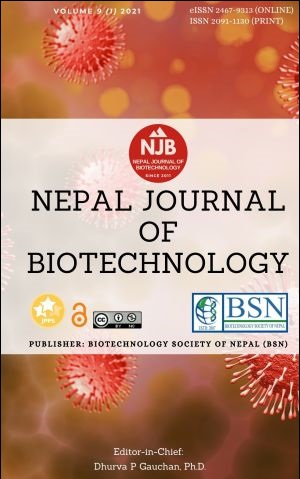Evaluation of Phytochemical, Antioxidant and Antibacterial Activities of Selected Medicinal Plants
DOI:
https://doi.org/10.3126/njb.v9i1.38667Keywords:
Antibacterial activity, Medicinal plants, Secondary metabolites, Minimum inhibitory concentrationAbstract
Medicinal plants are important reservoirs of bioactive compounds that need to be explored systematically. Because of their chemical diversity, natural products provide limitless possibilities for new drug discovery. This study aimed to investigate the biochemical properties of crude extracts from fifteen Nepalese medicinal plants. The total phenolic contents (TPC), total flavonoid contents (TFC), and antioxidant activity were evaluated through a colorimetric approach while the antibacterial activities were studied through the measurement of the zone of inhibition (ZoI) by agar well diffusion method along with minimum inhibitory concentrations (MIC) by broth dilution method. The methanolic extracts of Acacia catechu and Eupoterium adenophorum showed the highest TPC (55.21 ± 11.09 mg GAE/gm) and TFC (10.23 ± 1.07 mg QE/gm) among the studied plant extracts. Acacia catechu showed effective antioxidant properties with an IC50 value of 1.3 μg/mL, followed by extracts of Myrica esculenta, Syzygium cumini, and Mangifera indica. Morus australis exhibited antibacterial activity against Klebsiella pneumoniae (ZoI: 25mm, MIC: 0.012 mg/mL), Staphylococcus aureus ATCC 25923 (ZoI: 22 mm, MIC: 0.012 mg/mL), Pseudomonas aeruginosa (ZoI; 20 mm, MIC: 0.05 mg/mL), and methicillin-resistant Staphylococcus aureus (MRSA) (ZoI: 19 mm, MIC: 0.19 mg/mL). Morus australis extract showed a broad-spectrum antibacterial activity, followed by Eclipta prostrata, and Hypericum cordifolium. Future study is recommended to explore secondary metabolites of those medicinal plants to uncover further clinical efficacy.
Downloads
Downloads
Published
How to Cite
Issue
Section
License
Copyright (c) 2021 Biotechnology Society of Nepal

This work is licensed under a Creative Commons Attribution-NonCommercial 4.0 International License.
Copyright Notice:
The manuscript submitted to NJB must be an original contribution, not previously published and should not be under consideration for publication elsewhere. When the manuscript is accepted for publication, the authors agree to automatically transfer the copyright of the article to the publisher. It should grant permission to any third party, in advance and in perpetuity, the right to use, reproduce or disseminate your article, according to the NJB copyright and license agreement.
Authors transfer copyright to the publisher as part of a journal publishing agreement but have the rights to: Share their article for Personal Use, Internal Institutional Use and Scholarly Sharing purposes, with the NJB applies the Creative Commons Attribution-NonCommercial CC BY-NC license to all the works we publish after Jun 2020 (Before it was CC BY-NC-ND). Under this license, authors agree to make articles legally available for reuse, without permission or fees, for virtually any non-commercial purpose. Anyone may remix, adapt, and build upon your work non-commercially, and although their new works must also acknowledge you and be non-commercial, they don’t have to license their derivative works on the same terms. More details on CC BY-NC refer to its Licence Deed and Legal Code.






